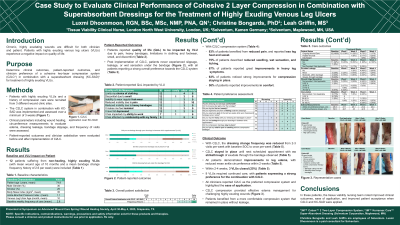Case Series/Study
(CS-018) Case Studies to Evaluate the Clinical Performance of Cohesive 2 Layer Compression in Combination with Superabsorbent Dressing for the Treatment of Highly Exuding Venous Leg Ulcers
Friday, May 2, 2025
7:45 PM - 8:45 PM East Coast USA Time

Luxmi Dhoonmoon, TVN – London North West University, London, UK; Leah Griffin, MS – Director HEOR, Medical Affairs, Solventum
Introduction: Compression therapy improves healing outcomes and lowers recurrence of venous leg ulcers (VLUs).1,2 The aim of this case study series was to determine clinical outcomes, patient reported outcome and clinician preference of a cohesive two-layer compression system (C2LC)* in combination with a Superabsorbent Dressing (KC-SAD)† for treatment of highly exuding venous leg ulcers (VLUs).
Methods: Patients with highly exuding VLUs and a history of compression care were recruited from 3 different wound clinic sites by tissue viability nursing specialists. C2LC system in combination with KC-SAD was implemented and assessed over a minimum of 3 weeks. Clinical parameters including wound healing, circumference measures to evaluate oedema, dressing leakage, bandage slippage, and frequency of visits were assessed. Additionally, patient-reported outcomes and clinician satisfaction were evaluated before and after implementation of C2LC.
Results: Patients with history of highly exuding VLUs and compression care were included in this case series (n=12). With C2LC the dressing change frequency was reduced from 2-3 visits per week to once per week. C2LC stayed in place until next scheduled appointment with no strikethrough of exudate through the bandage observed. All patients demonstrated improvements in leg oedema, with reduced mean ankle circumference from 29.4 cm to 25.1 cm within 2 weeks. Within 2-4 weeks, 3 VLUs closed and 9 required continued care, with patients expressing a strong preference for the continuation with C2LC. All clinicians reported C2LC as the preferred compression system and highlighted the ease of application.
Discussion: In these patients, the tissue viability nursing team noted improved clinical outcomes, ease of application, and improved patient acceptance when C2LC and KC-SAD were used as compression care.
Methods: Patients with highly exuding VLUs and a history of compression care were recruited from 3 different wound clinic sites by tissue viability nursing specialists. C2LC system in combination with KC-SAD was implemented and assessed over a minimum of 3 weeks. Clinical parameters including wound healing, circumference measures to evaluate oedema, dressing leakage, bandage slippage, and frequency of visits were assessed. Additionally, patient-reported outcomes and clinician satisfaction were evaluated before and after implementation of C2LC.
Results: Patients with history of highly exuding VLUs and compression care were included in this case series (n=12). With C2LC the dressing change frequency was reduced from 2-3 visits per week to once per week. C2LC stayed in place until next scheduled appointment with no strikethrough of exudate through the bandage observed. All patients demonstrated improvements in leg oedema, with reduced mean ankle circumference from 29.4 cm to 25.1 cm within 2 weeks. Within 2-4 weeks, 3 VLUs closed and 9 required continued care, with patients expressing a strong preference for the continuation with C2LC. All clinicians reported C2LC as the preferred compression system and highlighted the ease of application.
Discussion: In these patients, the tissue viability nursing team noted improved clinical outcomes, ease of application, and improved patient acceptance when C2LC and KC-SAD were used as compression care.

.jpg)
